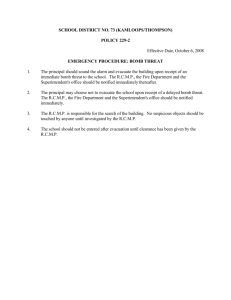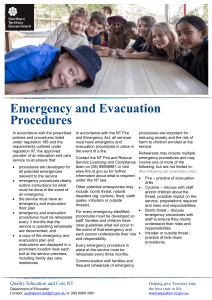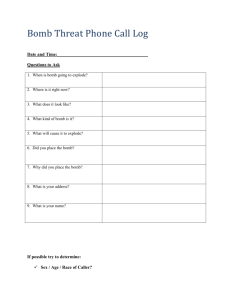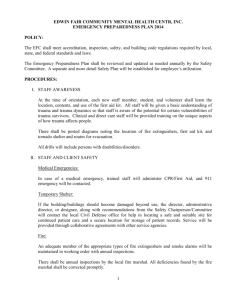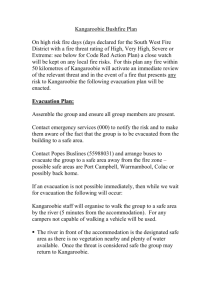Word Version - Louisiana State Police
advertisement
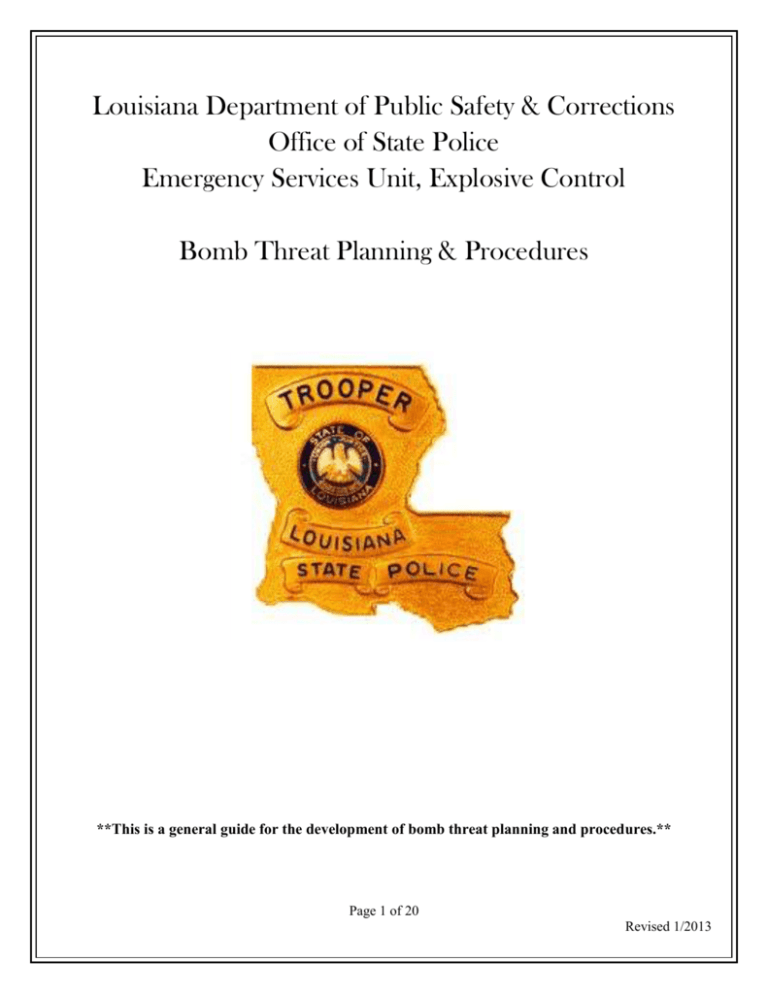
Louisiana Department of Public Safety & Corrections Office of State Police Emergency Services Unit, Explosive Control Bomb Threat Planning & Procedures **This is a general guide for the development of bomb threat planning and procedures.** Page 1 of 20 Revised 1/2013 BOMB THREAT PLANNING & PROCEDURES TABLE OF CONTENTS Forward .............................................................................................................................Page 3 I. Defined ...................................................................................................................Page 4 II. General ...................................................................................................................Page 4 III. Planning & Preparation .......................................................................................Page 4 IV. Prevention ..............................................................................................................Page 6 V. Receiving a Threat ................................................................................................Page 9 VI. Evacuation .............................................................................................................Page 12 VII. Search .....................................................................................................................Page 15 VIII. Appendix A ............................................................................................................Page 19 Potential Concealment Areas IX. Appendix B ............................................................................................................Page 20 Emergency Contact Numbers Page 2 of 20 Revised 1/2013 FORWARD Bomb threats and actual bombings are presently on the increase in the United States. Organization and planning efforts must be conducted in advance to handle bomb threats, confusion, and panic. Responsibility should not be avoided or further delegated by those in authority. This document is intended to assist management with the formulation and development of bomb threat plans and procedures. The ideas and suggested methods outlined were gathered from many sources and reflect the most current information available on bomb threats. While it is true that a single concept of bomb threat policy to cover all activities and situations would not be practical, it is equally true that certain basic considerations will apply in most bomb threat incident plans. Each facility must decide for itself which of these considerations apply to their specific needs. PREPAREDNESS must be emphasized. When facilities are equipped with an organized plan, most bomb threat problems can be resolved with a minimum of exposure to personal injury and property damage. By making this information available to you, we are attempting to help you help yourself in handling bomb threats and illegal employment of explosives or incendiaries. There is no final word available on this subject and it is recognized by all that there may be a better way; it is with this in mind that we solicit any comments or suggestions from you. Page 3 of 20 Revised 1/2013 BOMB THREATS I. DEFINITION A bomb threat is generally defined as a threat, usually verbal or written, to detonate an explosive or incendiary device to cause property damage, death, or injuries, whether or not such a device actually exists. II. GENERAL The most common reasons for making a bomb threat are to disrupt normal activities and minimize the risk of injury to others. Bombers, especially terrorists, normally aren’t random attackers. Terrorists usually select targets based upon the potential publicity and political or psychological gain that might be achieved by a bombing. Generally, terrorist bombings are meant to destroy property, but not endanger lives; however, this generalization has not always held true and should not be accepted as a routine guideline. Criminal bombers, other than terrorists, select targets for a variety of reasons, with revenge, extortion, and intimidation being among the most prominent motives. In developing a bomb threat response plan, there are four general areas of consideration: (1) Planning and Preparation, (2) Receiving a Threat, (3) Evacuation, and (4) Search. The information presented under each of these four topics will assist in the preparation of an effective bomb threat plan. The suggested methods described in this document will apply in most cases; however, specific requirements will be unique for each facility and will need to be worked out on an individual basis. Once the function of the organization, size of the facility, number of personnel, location and relation of other establishments, and available resources are evaluated; a comprehensive bomb threat plan can be developed. III. PLANNING & PREPARATION Facilities that are best prepared for a “bomb threat” will meet the threat most effectively. With a well thought out plan, a bomb threat situation can be resolved with a minimum of risk to people and property, while minimizing the disruption of normal operations. Proper preparation also encompasses practice and evaluation of the bomb threat plan. It is only with a properly organized plan will those affected by a bomb threat know how, when, and in what order to proceed. It is highly recommended that liaison be maintained between the facility likely to be subject to a bomb threat and those public safety agency teams charged with responding to bombing incidents. Through such contact, it will be possible to determine what technical and training services might be needed. Page 4 of 20 Revised 1/2013 It should be noted that while some public safety agencies may provide considerable aid in bomb threat situations, facilities must plan and carry out the major portion of the plan to include internal control and decision making. Liaison and coordination are both factors in which a bomb threat plan must take into consideration, especially when neighboring establishments or businesses may share the same building. This coordination should assure smooth handling of the bomb threat with minimum inconvenience to all those affected. Control is especially important during evacuation and search efforts and effective security will lessen the risk of an actual explosive device ever being planted. Preparation should also include clear-cut primary and alternate levels of authority, along with designated primary and alternate individuals to perform tasks required at the different levels of authority. People assigned to such key positions are usually management or supervisory personnel. Each should be familiar with the scope and responsibility of the assignment, and have full authority to make necessary decisions. Possibly the most important decision for these people will be whether to evacuate a building in the face of a bomb threat. A single person should be vested with the authority to order and direct the evacuation, search, shutdown, re-entry, and other emergency procedures. When the person who has the authority orders an evacuation, that person will be in charge of the bomb threat control center from which all operations will be directed. If a mobile control center is deemed impractical, two locations (a primary and an alternate) should be designated as a stationary control center. There should be an establishment search teams. The most likely candidates are volunteers from those who work in the affected building(s). Security and maintenance people are also good choices because they are familiar with both public and out-of-the-way areas. These people are best suited for this task as they are most familiar with the areas and they know what items belong in certain areas. It is very important that those assigned to this task do so without hesitation and in a professional manner. Professionalism by all those involved in the operation will instill confidence in those subjected to abnormal procedures. When selecting members of the search team, one aspect to think about it fatigue. Since a thorough search can be lengthy, it is important to select people who a physically qualified to handle fatigue. Effective training can help lessen the effect of hours of tedious searching, but other measures to alleviate fatigue should be available. A map dividing the facility into distinct search areas should be prepared. Using a systematic approach, the most likely hiding places and the more difficult areas can be searched first while the teams are freshest. If a prolonged search is unavoidable, search teams should be given break periods. Page 5 of 20 Revised 1/2013 After the selection of search teams has been designated, it is extremely important to train these teams in thorough search procedures. It should be emphasized that their role is strictly to that of a “searcher” and not as bomb experts. The designated search personnel should familiarize themselves with the normal building sights, sounds and smells in order to detect anything out of the ordinary. These members should also be provided with the following items: flashlight, knife, screwdrivers, crescent wrench, probe, extension mirror, tape, twine and chalk or some other type of marking material to mark searched areas. In your development of the bomb threat plan, it is important to determine the search sequence and procedures. Search techniques will be discussed in detail in the “Search” chapter of this document. Also in the planning of your bomb threat plan, it is important to designate a control center, its operators and communication procedures. A mobile control center can be set up outside of the building or locations can be used within the facility. However you decide, there should be an alternate location as a precaution. These locations should be able to handle numerous calls at one time. Although publicity in a bomb threat situation is not sought, a person should be selected as the media spokesperson. This will ensure the availability of accurate information to the media and could help prevent additional bomb threats resulting from the publicizing of false information. Once a bomb threat plan has been made and approved by the appropriate facility, all employees, to include part-time employees, should be made familiar with the procedure. IV. PREVENTION When making plans to address explosive/incendiary devices, the vulnerability of a given location or facility must be considered. Facility management should ask themselves - What restrictions or difficulties would someone encounter if they wanted to place an explosive/incendiary device in your facility? In order to reduce the potential placement of an explosive/incendiary device, you can tighten physical security. Not only will you reduce the chances of having a device brought on to the premises, but you can also maximize search efforts by doing the following: A. During the inspection of the building, particular attention should be given to such areas as elevator shafts, ceiling areas, restrooms, access doors, crawlspaces and other areas which are used as a means of immediate access; plumbing fixtures, electrical fixtures, utility and closet areas, areas under stairwells, boiler (furnace) rooms, flammable storage areas, electrical switches, gas or fuel valves, indoor trash receptacles, record storage areas, mail rooms, ceiling lights with easily removable panels, and fire hose racks. Page 6 of 20 Revised 1/2013 While this list of areas to be noted with particular emphasis is not complete, it is sufficient to give an idea of those areas where a time-delay explosive/incendiary device might be concealed. A more concise list of potential concealment areas is found in Appendix A, “Potential Concealment Areas.” B. Establish and enforce strict procedures for the control and inspection of packages and materials going into critical areas. C. Develop and enforce a positive means of identifying and controlling personnel who have authorized access to critical areas and denying access to unauthorized personnel. D. Instruct all security and maintenance personnel to be alert for suspicious individuals. All personnel should be alert to the presence of foreign or suspicious objects or parcels which do not appear to belong in the area where they are observed. E. Instruct all security and maintenance personnel to increase surveillance throughout the building especially of all restrooms, stairwells, and areas under stairwells to ensure that unauthorized personnel are not in hiding or concealment. F. Ensure that doors and/or access ways to such areas as boiler rooms, mail rooms, computer areas, switchboards, elevator machine rooms and utility closets are securely locked when not in use. G. Check key control procedures to see that all keys to all locks are accounted for. If keys are in possession of persons no longer in your employment or keys cannot be accounted for, then all locks should be changed. Combination locks should be changed semi-annually. H. Check fire exits to make sure they are not obstructed. I. Check fire hose racks and fire extinguishers regularly to assure they have not been damaged, i.e., hoses cut, exposed to acid, or damaged nozzles. J. If the facility is large enough to have its own high pressure fire hydrant system make periodic checks of the fire hydrants. There have been instances where fire hydrants were made inoperable by the insertion of beverage cans into the outlets of the fire hydrant stem. One method of combating this is to place seals on the outlet caps and make periodic inspections. If it appears that the seals have been disturbed or tampered with, then test the hydrant to ensure that it is operable. K. Increase patrols and surveillance of receiving and shipping areas, garages and parking areas. Page 7 of 20 Revised 1/2013 L. Ensure adequate protection for classified documents, proprietary information and other records essential to the operation of your facility. A well placed device could upon detonation destroy all records which are vital for day-to-day operations). M. Check perimeter fences/walls/barriers to assure a good state of maintenance and adequate clear zones and post "No Trespassing" signs. N. Check all exterior and protective lighting for proper operation and adequate illumination. O. Protect ground-floor windows with heavy mesh, grillwork, or protective glass. P. Conduct daily checks for good housekeeping and proper disposal of combustible material. Q. In the event electric power is shut off, have flashlights or battery powered lanterns available. R. Install closed circuit television to monitor areas where a device might be placed. S. If possible, install metal detecting devices. T. Post signs indicating the use of closed circuit televisions and other detection devices. U. Entrances and exits to and from buildings could possibly be modified to channel all personnel entering or leaving the building, by a registration desk. Persons entering the building should be required to sign a register showing the name and room number of the person whom they wish to visit. Employees manning these registration desks could contact the person being visited and advise that a visitor, by name, is in the lobby. A system for "signing out" when the visitor departs the building should be integrated into this procedure. There is no question that the institution of such a procedure would result in many complaints from the public. On the other hand, it could be explained to the visitor at the registration desk that these procedures are being implemented in the best interest and safety of the visitor. Page 8 of 20 Revised 1/2013 V. RECEIVING A THREAT It is very important in the preparation of a bomb threat that all personnel who handle incoming calls to your facility that they be supplied with a bomb threat checklist. When a threat is received, it may be advisable for the person receiving the call to give some type of prearranged signal. This signal should be made aware of in the Planning and Preparation phase, but can be as simple as holding up a red card. This can allow monitoring of the call by more than one person, and it would enable someone else to attempt to record and/or trace the telephone call. If it is available at the facility receiving the threat, recording the telephone call can reduce the chance of error in documenting the information provided during the bomb threat. This information can serve as great evidence which is valuable to the investigation and assist in evaluating the authenticity of the bomb threat. It should be made aware that some local jurisdictions may have laws restricting this type of recording. If your facility does not have a continuous recording setup, you can contact your local telephone company and they may be able to provide specific services that may fit your needs. Regardless of whether the bomb threat call is to be recorded and/or monitored, the person handling the call should remain calm and concentrate on the exact wording of the message and any other details which could prove valuable in evaluating the threat. While comprising a smaller percentage of bomb threats, the written bomb threat must be evaluated as carefully as one received over the telephone or the Internet. These written threats often provide excellent evidence to the investigating authorities. Once a written bomb threat is recognized, further handling of the document should be avoided in order to preserve fingerprints, handwriting, typewriting, postmarks, and any other markings for forensic examination. This can easily be done by simply placing the document in a clear sheet protector or large Ziploc bag so that handling is minimized, but the information on the document can still be referenced and evaluated. All items that came with the threat (envelope, etc.) should be saved for the investigating authority. After a bomb threat is received, the next step should be is to immediately notify the people who are responsible for carrying out the bomb threat response plan. During the Planning and Preparation Phase, it is important to prepare a list of those individuals and agencies to be notified in the event of a bomb threat. In addition to those already mentioned, the local police department, fire department, medical facilities, neighboring businesses, and local utility companies are usually among those whose emergency contact information should be included on such a list. The bomb threat must now be evaluated for its potential authenticity. Factors involved in such an evaluation are difficult and any subsequent decision is often based on little reliable information. Until proven otherwise, each bomb threat should be treated as though it involved an actual explosive device; even though threats in which an Improvised Explosive Device (IED) is present comprise a small percentage. Page 9 of 20 Revised 1/2013 Procedures for Handling a Communicated Threat A. When the caller has communicated the threat, stay calm, do not manifest fear. Make a note as to the date and time of day. B. Keep the caller on the line and talking, the more he/she says the more you will learn. C. Record every word the caller says. D. If the caller does not indicate the location of the bomb or the time of detonation, ask the caller what time it is to detonate and where it is located. If the caller has answered any of the above questions and is still on the line, ask him his name and try to ascertain where he is calling. Although the caller may not respond, we will never know unless we ask. E. It may be advisable to inform the caller that the building is occupied and the detonation of a bomb could result in death or serious injury to many innocent people. F. Note the characteristics of the caller: (1) Sex (2) Age (3) Race (4) Demeanor (5) Accent (Is the voice native to the area?) (6) Speech impediments or peculiar voice characteristics (lisp, stutter, intoxicated, etc.) (7) Pay particular attention to any strange or peculiar background noises; such as street noises, motors running, music, television or radio programs, dishes rattling, babies crying, and other background noise which might give even a remote clue as to the origin of the call. NOTE: See “Bomb Threat Checklist” (8) Notify only those persons designated in the plan. Do not discuss the call with anyone unless authorized to do so. Do not leave your post or assignment unless instructed to do so by the person in charge. Page 10 of 20 Revised 1/2013 Page 11 of 20 Revised 1/2013 VI. EVACUATION Many bomb threats are simply pranks perpetrated by employees or students who know that this sort of unconditional bomb threat policy will get them time off from work or school. All bomb threats should be evaluated on their own merits and an evacuation should only be conducted if deemed necessary. Having evaluated the credibility of a bomb threat, it is necessary to decide whether to: (1) Take No Action, (2) Search Without Evacuation, (3) Initiate a Partial Evacuation, or (4) Conduct a Complete Evacuation and Search. To avoid the possibility of risk, a blanket policy to evacuate upon receipt of a bomb threat can be established during the planning and preparation, but if the threat is a hoax, such policy could result in considerable production loss and could be costly in the terms of dollars; which could be playing right into the bomb threat maker’s hands. There are a few factors to be weighed in conjunction with the bomb threat evaluation and deciding or not to evacuate: (1) The possibility of an effective search without a total evacuation, (2) The liabilities involved if an explosion occurs and the building was not evacuated, and (3) Proximity and danger to neighboring buildings, or to other businesses sharing the same building. A partial evacuation may be feasible depending on the type, size, and construction of the structure. If the facility is a large multi-story building with solid concrete walls between rooms, it may be sufficient to evacuate only those offices in the immediate area of the bomb threat, plus one or two floors above or below. Evacuees can be relocated to an unaffected area of the building and near exit routes in the event of an explosion. If a complete evacuation of a facility is ordered, primary and alternate evacuation routes should be searched first. In the event an IED is found, the route may be changed ahead of time. It is important to understand that a bomb threat evacuation is more complicated than a typical fire drill. A bomb threat evacuation requires greater control and supervision, especially if no reason is given for the evacuation. Prior to employees leaving their office spaces, employees should unlock desks, lockers, and file cabinets; turn off office machinery, but leave the lights on. All personal belongings (bags, purses, backpacks, lunchboxes, brief cases, etc.) should be taken with the evacuee because this might cause unnecessary screening during the building search phase. As a precaution in the event of an explosion, windows and doors should be opened to vent and minimize blast fragmentation and damage. Once all people are evacuated, they can be directed to a holding area out of the range of blast propelled debris. Page 12 of 20 Revised 1/2013 Summary of Recommended Evacuation Procedures A. Publish a list with primary and alternate evacuation routes and name(s) of personnel authorized to order a partial or complete evacuation and re-entry. Primary and alternative evacuation routes are especially important in the event an actual or suspected bomb is located. B. Establish an evacuation signal. If the fire alarm is to be used, remember that doors and windows are closed in the event of a fire; while the opposite is advisable when a bomb may be involved. If a voice announcement is used, it should be made in a clear, calm, confident manner. Drill can be helpful to avoid disorder. C. Select and train evacuation teams. Training must prepare team members to control and direct evacuees with reassurance, and to handle any procedural changes during an evacuation with confidence. Properly trained teams familiar with evacuation procedures, possible hazards, and primary and alternate routes can help ease adverse reactions. Team members assigned to these duties should wear some type of identification indicating their authority during this event. D. Establish evacuation “holding areas,” where evacuees may wait safely and comfortably until the danger is over. Such locations should be away from any potential hazards in the event of an explosion, and should offer protection in the event of unfavorable weather conditions. E. Provide for communication and security requirements during evacuation and search. Re-entry by unauthorized personnel should not be permitted during the evacuation and search phase. Page 13 of 20 Revised 1/2013 Bomb Threat Stand-Off Chart NOTE: This chart should be used as a general guide to assist you in determining a safe evacuation distance. Page 14 of 20 Revised 1/2013 VII. SEARCH Most all public safety agencies and military Explosive Ordnance Disposal teams are in agreement that the most effective and fastest search of a facility can best be made by the normal occupants of that building. Since the bomber does not usually label an explosive device with the word "bomb", what are the things that your employees should you look for? Explosive devices can be packaged in as many different ways as the bombers imagination will allow. Some explosive devices may be the size of a cigarette package, while others may be as large as a moving truck. Since the object of the search can vary in size and shape, it is a general rule that the search should be conducted by people who are familiar with the area in order to notice a strange or foreign object. However, the use of personnel who occupy the premises to conduct the search may present problems in view to the hysteria that might result from the threat unless there has been careful planning beforehand. In designating or assigning personnel to an area to be searched, there should be no reluctance to assign females, if they are the ones most familiar with the area. Women are as qualified as men to carry out this function. In the Planning and Preparation phase, search teams should be identified. A very practical and effective approach to the selection of search teams is to make the selection from personnel familiar with specific areas of the building. These persons should be able to direct specific searches and relay information to the control center. As mentioned previously, these persons should be provided with some type of designated marking which identifies them as emergency personnel. Once a threat has been received, it must be determined on how to best conduct the search sequence and procedures. Not every threat is the same, so the information received during the threat will drive the sequence and exact procedures. The order of the search sequence usually starts with a thorough search of the outside areas (i.e. shrubs, window boxes, trash containers, ornamental structures, vehicles parked around the building, etc.), building entrances and lobbies, and public areas (i.e. restrooms, stairways, elevators, elevator shafts, etc.). Due to their ease of accessibility, these areas should be searched very carefully, with special caution exercised when opening doors for the potential presence of booby traps. Once the outside and public areas have been searched and cleared, the search on the inside of the facility should begin, usually in the basement. It should be noted that when searching elevators, utility closets, and basements which contain large machinery, a building engineer or maintenance personnel familiar with the area, accompany the search team so that they can provide information in the event it is needed. Page 15 of 20 Revised 1/2013 Prior to a physical search of a room, a visual search should be made first. The room should be divided into areas of responsibility, giving each searcher an equal number of places to search. Both the visual and physical search should progress in stages (i.e. floor-to-waist, waist-to-eye-level, eye-level-to-ceiling, and under false or suspended ceilings). As a room or floor is cleared, chalk or tape can be used to indicate that it has been searched. Upon the searching of these locations, it is a good idea to avoid saying that no bomb was found there, instead as each area is cleared, a simple statement that no bomb was found should be sufficient. In an area that is being searched, it is highly recommended that the search area environment remains in the state that the searcher first arrives. If the lights are off when beginning the search, they should be left off. As mentioned previously, the search teams should have access to flashlights or other types of lighting. Booby-trapped switches can be improvised for use in many seemingly innocent ways. For this reason, lamps, rugs, drapes, pictures and light switches should not be disturbed without first determining whether a booby trap switch mechanism is involved. The search techniques discussed generally enable searchers to check first those areas most likely to be used to hide an IED. In instances where this is not true, the search sequence should be modified to allow such places to be checked early in the search. It is always good practice to search logical bomb threat targets before searching elsewhere. In the event that a suspected IED is located, DO NOT TOUCH IT! Do not assume it to be the only one either, as there may be a secondary device. Note the IED’s location, description and proximity to utilities (e.g. gas lines, water pipes and electrical panels). You should then move to the preferred evacuation distance area and relay this information to the control center. A discovery of a suspected IED does not end the search. More IED’s may be present and search efforts must continue until the entire facility has been checked. Call the local bomb disposal unit for immediate assistance. If an explosion has occurred, do not tamper with the debris. Call for help, remove any casualties and secure the area until the Bomb Squad arrives. A blast may loosen or weaken adjacent structures in the area. Exercise caution to avoid additional injuries from such post-explosion hazards. In the event that no IED is found, the decision to re-enter will be influenced mostly by the confidence in the search procedure. Page 16 of 20 Revised 1/2013 A. B. Effective Search Techniques: (1) Security, maintenance and janitorial personnel search such areas as hallways, rest rooms, stairwells, elevator shafts, utility closets, and areas outside the building. Office personnel search their immediate areas. (2) As the search of each area is completed and no suspicious objects found, a report is given to the appropriate warden. Suspicious Object Located: NOTE: It is imperative that personnel involved in the search be instructed that their mission is only to search for and report suspicious objects. NOT to move, jar or touch the objects or anything attached thereto. The removal/disarming of an explosive/incendiary device must be left to professional Bomb Technicians. C. (1) The location and a description of the object should be reported to the floor warden. This information is relayed immediately to the person in charge of the control center who will call police, fire department and rescue squad. When these agencies arrive, they should be met and escorted to the scene. (2) The danger area should be identified, and blocked off with a clear zone of at least 300 feet, including areas below and above the object. (3) Check to see that all doors and windows are open to minimize primary damage from blast and secondary damage from fragmentation. Communications During Search: (1) A rapid two-way communication system is of utmost importance. Normally communication between wardens, search teams and the control center can be accomplished through the existing telephone system, or the building's internal communication system. (2) In many instances, two-way (walkie-talkie) radios have been used. Page 17 of 20 Revised 1/2013 SOURCES Bureau of Alcohol, Tobacco, Firearms and Explosives United States Department of Justice, Federal Bureau of Investigation, Behavioral Analysis Unit United States Department of Justice, Federal Bureau of Investigation, Devices Operations Center Federal Aviation Administration International Association of Chiefs of Police Office of the Provost Marshal General, Department of the Army Louisiana State Police REFERENCES FBI: Caught on Camera General Information Bulletin 2000-3, Suspicious Letter/Package Poster, 11 June 2010, FBI, Bomb Data Center Handbook of Forensic Services, pages 18-20 Bomb Threat Stand-Off Card, 2 December 2009, FBI, Bomb Data Center/DHS, Office of Bombing Prevention General Information Bulletin 2012-1, The Bomb Threat Challenge, FBI, Bomb Data Center Bomb Threat Checklist, Bureau of Alcohol, Tobacco, Firearms & Explosives, ATF F 1613.1 Page 18 of 20 Revised 1/2013 VIII. APPENDIX A POTENTIAL CONCEALMENT AREAS Buildings and Structures: 1. Elevator wells and shafts. (CAUTION: Watch for strong winds in elevator shafts) 2. Nooks 3. Closets 4. Storage rooms 5. False Panels 6. Walk areas 7. Counterweights 8. Motors 9. Cables 10. Trash in shafts 11. All ceiling areas 12. Restrooms 13. Access doors 14. Crawl space in restrooms and areas used as access to plumbing fixtures 15. Electric fixtures 16. Utility and other closet area 17. Space under stairwell 18. Boiler (furnace) rooms 19. Flammable storage areas 20. Main switches and valves 21. Indoor trash receptacles 22. Storage areas, including record-storage areas 23. Mail rooms 24. Ceiling lights with easily removable panels 25. Fire hose racks 26. Basements 27. Around windows hidden by drapes or shades 28. Inside desks 29. Inside storage cabinets and containers 30. Under tables Auditoriums and Theaters: 1. Seating (cut seat cushions) 2. Stage area 3. Microphones 4. Speaker platform 5. Crawl ways 6. Tunnels 7. Trapdoors 8. Dressing rooms 9. Restrooms 10. Storage areas 11. Ceilings 12. Props 13. Hanging decorations 14. Lighting fixtures 15. Sound system 16. Air Conditioning system 17. Roof 18. Heating system 19. Projection booths 20. Offices Outside Areas: 1. Street drainage systems 2. Manholes in street and sidewalk 3. Trash receptacles 4. Garbage cans 5. Dumpsters 6. Incinerators 7. Mailboxes 8. Parked cars, trucks, and carts 9. Storage areas 10. Evacuation staging area Schools: 1. Lockers 2. Boiler (furnace) rooms 3. Utility closets 4. Offices 5. Chemistry labs 6. Auditoriums 7. Cafeterias (see above) Page 19 of 20 Revised 1/2013 IX. APPENDIX B EMERGENCY CONTACTS Louisiana State Police Emergency Services Unit Explosive Control P.O. Box 66168 Baton Rouge, LA 70896 Hotline - 877-925-6595 Louisiana State Police Troops: Baton Rouge................ Troop A ....................(225) 754-8500 New Orleans................ Troop B.....................(504) 471-2775 Grey............................. Troop C.....................(985) 857-3680 Lake Charles ............... Troop D ....................(337) 491-2511 Alexandria ................... Troop E .....................(318) 487-5911 Monroe ........................ Troop F .....................(318) 345-0000 Shreveport ................... Troop G ....................(318) 741-7411 Lafayette ..................... Troop I ......................(337) 262-5880 Mandeville .................. Troop L .....................(985) 893-6250 Sheriff's Department: _____________________________ Police Department: _______________________________ Fire Department: _________________________________ Hospital: _______________________________________ Unites States Department of the Treasury Bureau of Alcohol, Tobacco, Firearms & Explosives One Galleria Blvd, Suite 1700 Metairie, LA 70001 504-841-7000 United States Department of Justice Federal Bureau of Investigation 2901 Leon C. Simon Blvd. New Orleans, LA 70125 504-815-3000 Page 20 of 20 Revised 1/2013
